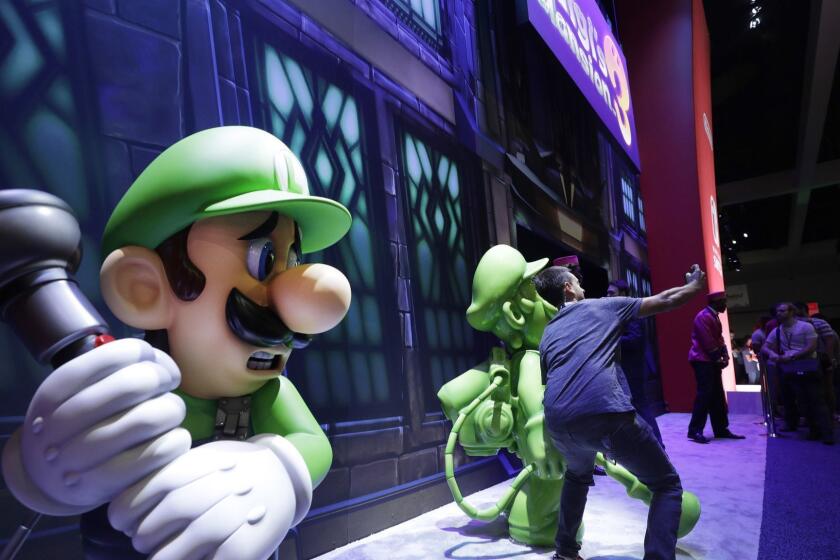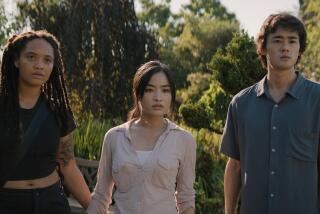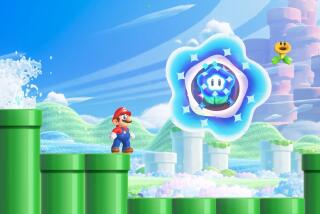Meet the new Mario and Luigi, as more than 2-dimensional caricatures
- Share via
There are ghosts aplenty in “Luigi’s Mansion 3,” and although the goal is to catch them, it’s sometimes preferable to try and get to know them.
There’s Clem, a maintenance worker with an apparent love for country and folk and a penchant for flooding the basement to relax in a rubber ducky pool float. And Ug, who dresses as if he’s trying out for “The Flintstones” and likes to possess dinosaur skeletons. And don’t forget Amadeus Wolfgeist, a classical music-loving specter, of course, with a wild, Jerry Lee Lewis-inspired streak, and Morty, apparently a French film director who would prefer to be left alone on his sets.
In “Luigi’s Mansion 3,” the latest in a line of Nintendo games that give Mario’s younger, lesser-known brother a starring role, an equal emphasis is placed on personality and puzzles. There’s silliness — Luigi captures ghosts with the help of a vacuum and a plunger and can take possession of a green blob alter-ego named Gooigi — but unlike a core element of many of the games in the “Super Mario Bros.” series, “Luigi’s Mansion 3” slows down to let players explore without a ticking clock. This gives us an opportunity to get to know Luigi and see another side of Mario, characters that can sometimes tend toward caricatures to suit the need of the game, be it racing karts or curing viruses.
“Luigi’s Mansion 3” is often goofy and charming — if there’s something on-screen, chances are it can be interacted with — and you’ll no doubt smile when Luigi uses his vacuum to successfully complete the tablecloth pull trick, as sight gags are hidden in practically every scene. There’s also an ever-so-slight underlying sense of tragedy to this Nintendo Switch offering. Luigi, after all, can’t get a break, even when he’s invited to a free, all-inclusive stay at a luxury hotel.
Mario has been Nintendo’s unlikely hero for more than 30 years — a plump plumber who dates outside his class and, as shown in the opening moments of one of the company’s upcoming adventures, won’t even carry his own luggage.
Worse, he often seems caught up in others’ affairs, be it the heroic Mushroom Kingdom adventures of his brother or, here, the returning Professor E. Gadd, who claims to study ghosts but also seems to fetishize collecting them to forever lock them away in display jars.
It turns out that the hotel invite was a ruse by ghosts to put an end to all those who aim to meddle in their endless lives; shortly after checking in at the start of the game, Mario, Princess Peach and some faithful Toads are frozen in portraits that could have been lifted from Disneyland’s Haunted Mansion.
It’s Luigi to the reluctant rescue. The previous game in the series, 2013’s “Luigi’s Mansion: Dark Moon” for the handheld 3DS, sold more than 6 million copies; no doubt a large part of that appeal rests in Luigi’s more relatable personality. He’s a man who shivers at the sight of a ghost; early in the game, his idea of a perfect night at the hotel is curling up with a book and a dog, a pup that just happens to be a ghost, hinting that Luigi would prefer to make peace with ghosts rather than being their adversary and opening himself up to haunts.
But trouble comes anyway. In the middle of the night, a Princess Peach scream awakens Luigi to the reality that the hotel is haunted, the posh trappings now replaced with spider webs, pop-out clowns in closets and toilets that sometimes fight back. But some of the gravest horrors are the more existential ones, as Nintendo’s designers — the game was produced by Kensuke Tanabe, best known for his work on the “Donkey Kong Country” and “Metroid Prime” franchises — dot the game with random details that can give one pause to ruminate. When we venture into the room of Luigi’s now kidnapped brother, we discover Mario used his chance alone to stuff his face with pizza, leading one to wonder how a life of fame may or may not torment the plump plumber.
We soon discover this hotel is anything but a place to rest, as one floor is a medieval dungeon, another a multilevel arboretum, and restaurants introduce us to an obsessively ornery ghost chef. The ninth floor is a museum, where a possessed T. rex tries to chomp down Luigi, and we fight back with pterodactyl eggs, which can materialize despite the creature being dead. Elsewhere, we explore a floor themed like an Egyptian tomb, where tiles trigger spikes to fly at Luigi’s head and a door gives way to a grand sandy vista populated with a pyramid. But the designers never lose sight that we’re still in a hotel; sometimes there are visible air conditioners, or beds buried beneath vines.
Actually, if the ghosts hadn’t kidnapped our pals, this seems like it’d be a fun place to move in. Hellen Gravely, a sort of 1930s movie star of a ghost, runs the hotel, and we’re told she uses a coveted form of makeup called GheistPaint. When she isn’t scaring her own ghost minions, they’re living their best afterlife. We see ghosts pretending to be sharks (not to be confused with a shark-pirate) and ballerinas. Luigi even disturbs one ghost trying to read a newspaper while on the toilet.
Although the bulk of the game is exploring, battles with said ghosts spring up from time to time. These unfold as mini-puzzles: to capture a ghost, we must first paralyze it with light; ghosts don masks, buckets, fans or anything handy to avoid looking at Luigi’s flash, the Strobulb.
Sometimes Gooigi, our friendly green blob that cannot be killed but also cannot become wet, must be used in tandem with Luigi, either as bait or as a way to create more vacuum-sucking power. While switching to Gooigi will at first leave Luigi in a sad, passed-out state — controlling the blob must take some human energy — hearing Gooigi loudly squish and slink his way around spikes and through vents is so weirdly appealing that the game’s moments of action can distract from our attempts to find hidden passageways.
Fortunately, as the game progresses, the fights become more outlandish, such as one that has Luigi and a ghost bumping each other in pool floats, a pool that appears to be filled with sewer water. The duel with Morty, the film director, is my favorite, as it’s not really a battle at all. Luigi can “win” simply by helping Morty rediscover the magic of filmmaking, and here “Luigi’s Mansion 3” becomes multiple games within a game, as looking through a camera will turn Gooigi into a sort of actor on various film sets, one where he’s stuck in a fire scene and another where’s he’s a miniature.
We meet Morty when he’s crying, lamenting that he can’t find his director’s bull horn. He wails, “What’s an artist without a brush? A chef without a knife? A dog without a bag of trash? Nothing!”
We must help Morty to continue on our quest to free Mario & Co., but don’t rush through the level, where a hotel floor has been turned into soundstages. Take your time toying with the various cameras and letting Gooigi play at being an actor as he encounters giant spiders and haunted wells hiding more than water. It’s a moment of joyous playfulness, a brief respite from the task at hand, but also one where we may ask, “What’s Luigi without Mario?” The answer: an absolute delight.
‘Luigi's Mansion 3’
More to Read
The biggest entertainment stories
Get our big stories about Hollywood, film, television, music, arts, culture and more right in your inbox as soon as they publish.
You may occasionally receive promotional content from the Los Angeles Times.












